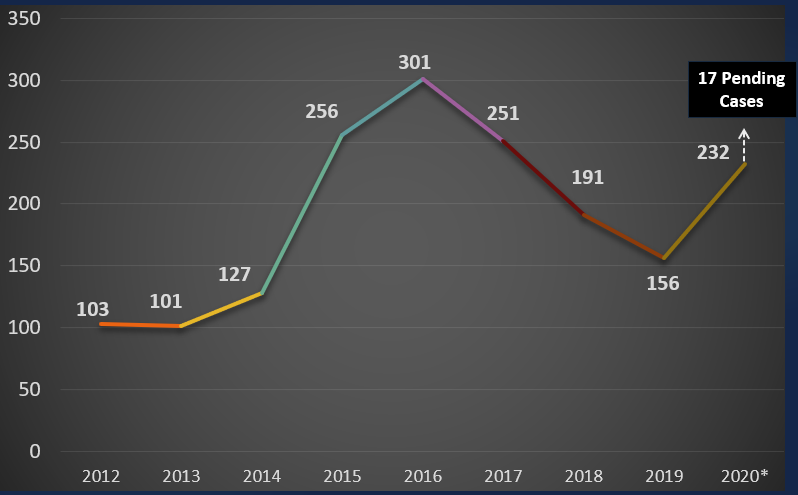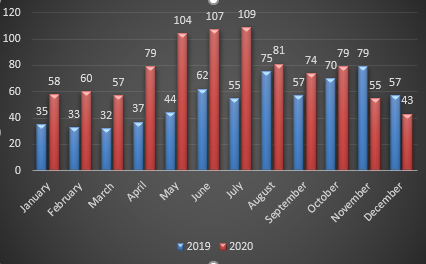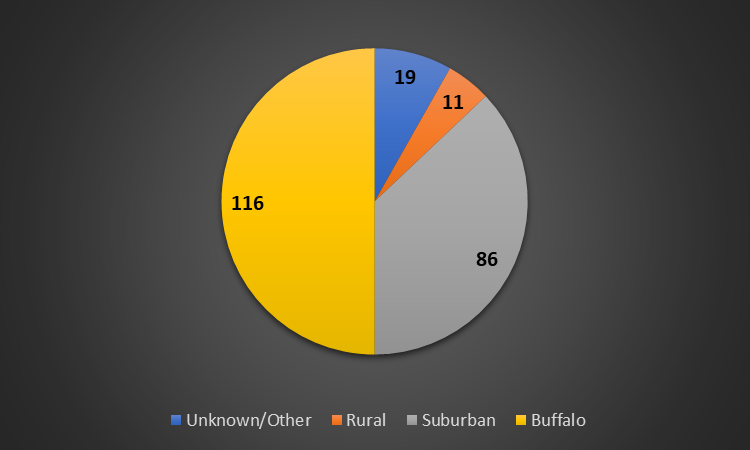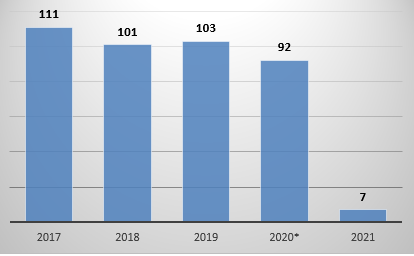Modified: February 24, 2021 2:38pm
Latest News
ERIE COUNTY DEPARTMENT OF HEALTH PROVIDES UPDATES, WARNINGS FROM OPIATE EPIDEMIC TASK FORCE
Cocaine and fentanyl are a deadly combination
Confirmed suicides in 2020 decreased 11% from 2019
The Erie County Addiction Hotline is available for individuals or those looking to help someone else with referrals to treatment and resources. Call (716) 831-7007. The Erie County Crisis Services Hotline is for anyone of any age experiencing a personal, emotional or mental health crisis. Call (716) 834-3131.
ERIE COUNTY, NY – The Erie County Department of Health (ECDOH) provided an update to the community on February 24, 2021, sharing concerning opioid-related overdose deaths trends and suicide death trends in Erie County.
County Executive Mark Poloncarz and Commissioner of Health Dr. Gale Burstein presented data from the Erie County Medical Examiner’s Office and the Opiate Epidemic Task Force to the public.
For 2020, the Erie County Medical Examiner’s Office confirmed 232 opioid-related overdose deaths, with 17 cases pending toxicology reports. Not including pending cases, this represents a 49% increase over the 156 opioid-related overdose deaths that Erie County recorded in 2019. This sharp increase follows a steady three-year decline (2016-2019) in opioid-related overdose deaths, from a peak of 301 in 2016.
In 2016, Erie County established the Opiate Epidemic Task Force to counter the rise in opioid-related overdose deaths. This collaborative effort brought together clinicians, families and consumers, law enforcement, educators, mental health specialists and treatment providers to apply the full force of community resources to this devastating community problem.
“Sadly, each one of these numbers represents a preventable death of one of our neighbors,” said County Executive Mark C. Poloncarz. “The concerted efforts of our Opiate Epidemic Task Force resulted in significant declines in opioid overdose deaths in prior years, but the COVID-19 pandemic prevented too many people from receiving the resources we offer to help and support them. Our community has demonstrated how to turn this terrible tide, and we have to do it again.”
ECDOH has also found that the percentage of overdose deaths with opioid and cocaine involvement climbed from about 15% in 2016 to 43% in 2020, based on 109 cases out of 232 confirmed opioid-related overdose deaths.
“The percentage of overdose fatalities with cocaine involvement is troubling, and we have to sound an even louder alarm that cocaine is not safe,” Commissioner of Health Dr. Gale Burstein added. “Cocaine in Erie County is likely to contain fentanyl, which is a powerful and dangerous opioid that can stop your breathing and end your life almost instantaneously. Don’t trust your cocaine.”
Also in 2020, toxicology reports showed that 84% of opioid-related overdose deaths involved fentanyl, with just 9% involving heroin.
ECDOH reports almost a doubling increase from 2018 to 2020 (10% to 19%) in the percentage of Black or African Americans confirmed as opioid-related deaths, and a 50% increase in individuals ages 40-49 year (14% in 2018 vs 22% in 2020). For that same time period, a 30% reduction in individuals ages 20-29 (29% in 2018 vs 19% in 2020) was noted.
ECDOH also reports that city of Buffalo residents accounted for 50% of opioid-related deaths in 2020, with suburban and rural residents accounting for 27% and 11%, respectively. “No community is insulated from the opioid epidemic,” said Opiate Epidemic Task Force director Cheryll Moore.
With data from ODMAPS and CHARMS, ECDOH has created a comparison of suspected overdoses between 2019 and 2020. [A note for this data set, it only captures overdoses reported by law enforcement and first responders, and may not include those treated at hospitals or those who survive in other settings.]
From these data, suspected opioid overdoses in 2020 showed increases compared to all months in 2019 except for November and December. Total suspected nonfatal overdoses in 2020 were up 42% over 2019 (636 in 2019, compared to 906 in 2020).
The availability of Narcan, and people trained in how and when to use it to reverse overdose effects, are key to preventing opioid-related overdose deaths. In 2020, Opiate Epidemic Task Force efforts led to the distribution of 464 emergency Narcan boxes in public places throughout Western New York and 624 Narcan kits. And, ECDOH’s innovative “Text for Narcan” program sent nearly 700 Narcan kits by mail since June 2020.
As the COVID-19 pandemic caused the cancellation of most in-person Narcan trainings, ECDOH shifted to free, online classes and mailing free Narcan kits to participants. ECDOH staff also provided on-the-spot Narcan trainings and supplies at socially distanced outreach events over the summer. That outreach continues in the early evening at the corner of Grant and Ferry streets in Buffalo on Tuesdays and at St. John Kanty Church’s parking lot in Buffalo on Thursdays.
Looking at other Erie County Medical Examiner’s office data, there were 92 confirmed suicides in 2020 (with 2 pending). This is an 11% decline from 2019, when 103 suicides were confirmed. For 2021, ECDOH has confirmed seven suicides. Erie County recorded 101 suicides in 2018 and 111 suicides in 2017. “This speaks to the resilient infrastructure that many of our region’s organizations have built over the past years to prioritize primary and secondary suicide prevention,” offered Dr. Burstein. “Mental health is public health, and suicide prevention resources are essential services.
If you are seeking help for yourself or a loved one, the Erie County Addiction Hotline is available 24/7 at 716-831-7007. You can also walk into any hospital emergency room and enroll in NY MATTERS to access MAT (medication assisted treatment) on the spot if medically eligible. The next Opiate Epidemic Task Force meeting is scheduled for May, and these meetings are open to the public.
#
All data are subject to change as toxicology reports are finalized.
2012 – 2020* Opioid Related Deaths, Erie County

Source: Erie County Medical Examiner’s Office, *Closed Cases Reported thru 2/22/2021
2016 – 2020* Percent of Opioid-related Deaths Associated with Opioids and Cocaine, Erie County

Source: Erie County Medical Examiner’s Office, *Closed Cases Reported thru 2/22/2021
Erie County Suspected Overdose (Sources: ODMAPS and CHARMS)

Source: Erie County Medical Examiner’s Office, *Closed Cases Reported thru 2/22/2021
2020, Percentage of Erie County Opioid-Related Deaths by Residence

Source: Erie County Medical Examiner’s Office, *Closed Cases Reported thru 2/22/2021
Erie County, Confirmed Suicides, 2017-2021

Source: Erie County Medical Examiner’s Office, *Closed Cases Reported thru 2/22/2021
- ECDOH Opioid Trainings: http://www.erie.gov/opioidtrainings
- Text for Narcan: 716-225-5473
- Request an Emergency Narcan Box for your business: (716) 858-7695 or https://www2.erie.gov/health/index.php?q=free-community-trainings-opioid-overdose-recognition-use-naloxone-reversal
- Never Use Alone: neverusealone.com or (800) 484-3731
- Erie County Addiction Hotline: (716) 831-7007
- Buffalo & Erie County Crisis Services Hotline: (716) 834-3131

